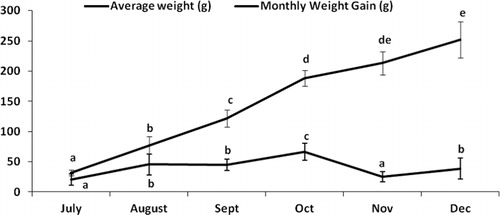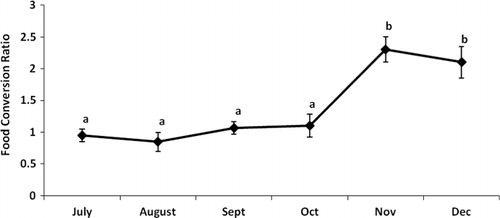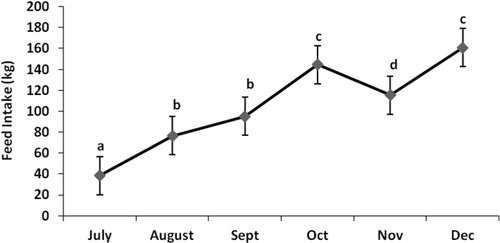Abstract
The aim of the present study was a preliminary experiment on marine culture of Asian sea bass in the shrimp earthen ponds of Gwadar region (a region located in the coastal area of Oman Sea, southeastern of Iran). To this end, Asian sea bass frys reared for 7 months including 1 month nursery and 6 months growth-period. During the culturing periods, fish were fed ad libitum by commercial rainbow trout diets based on fish growth stages. After nursery period, the average weight (AW) of 11.05 ± 1.5 g and survival per cent of 65% obtained for fish. During the growth-out period, the AW increased continually from 31.4 ± 4.7 g in late June to 252.1 ± 30 g at the end of growth-out period in late December. Also, the highest values of monthly weight gain yielded during August, September and October when fish had the AW range of (76.9 ± 14.4) – (188.1 ± 12.8) g. The values of monthly feed conversion ratio (FCR) were low and similar from July to October and then increased in November and December. The values of total monthly feed intake (FI) increased continually from July to October and then with a decrease in November, increased again in December. The values of survival per cent after nursery and growth-out period were 65% and 66%, respectively. Also, the average of monthly FCR, FCR at the time of fish harvesting, total FI and total harvested biomass were 1.36, 2.5, 630.5 kg and 325 kg.
1. Introduction
Food safety and food supply are of the key subjects with regard to the increasing population of the world. The experience of many countries have showed that aquaculture can plays a vital role in meet of protein resources especially for developing countries. During the recent decades, the culture of marine fishes have developed widely due to the high diversity and economic benefits in this context of aquaculture. One of the most appropriate marine fish for aquaculture is Asian sea bass that it’s culturing has expanded during last decade as cage culture and recirculation systems in many regions and countries such as Southeastern Asia, Australia and Saudi Arabia (Bhatia & Kungvankij Citation1971; Wongsumnuk & Maneewongsa Citation1974; Kungvankij Citation1981; Sakares Citation1982; Davis Citation1985; Matthew Citation2009). Asian sea bass is ecologically a euryhaline and catadromous species; inhabits freshwater, brackish and marine habitats including streams, lakes, billabongs, estuaries and coastal waters (Kungvankij et al. Citation1985; Matthew Citation2009). Some characteristics makes Asian sea bass an appropriate candidate for aquaculture. The characteristics including resistance to salinity changes and high stocking rate, appropriate acceptance of formulated diets and high growth and fecundity (Matthew Citation2009). In the present study, we examine the marine culture of Asian sea bass in the shrimp culture ponds of Gwadar region located in the coastal area of Oman Sea, southeastern of Iran. Sea bass culture can help to development and diversity of aquaculture in this region. Also, in this regard, the white spot disease (WSD) causes annually serious damages to shrimp culture industry. As well as, the isolation and useless of shrimp ponds for a few years in order to the control of WSD is not useful for economy of region. Therefore, an alternation in the type of cultured species can help to resolve this problem.
2. Materials and methods
The present research was conducted in shrimp culture complex of Gwadar. Gwadar region located in the coastal area of Oman Sea, southeastern of Iran. A number of 3000 Asian sea bass frys with average weight (AW) of 1–2 g were considered for experiment. The culture operation was carried out in two phases including nursery and growth-out. Before nursery, frys were acclimated to hatchery condition for 3 days and then distributed into the six 2000 l tanks with stocking rate of 500 frys per tank. The aeration of each thank was done gently by four air stones connected to air compressor. During nursery period, fish were feed ad libitum four times per day by commercial rainbow trout diets (i.e. SFT1). Also, the sorting operation and water exchange were conducted two days one time and weekly, respectively.
After nursery period, fish that now had the AW of 11.05 ± 1.5 g transferred to earthen shrimp ponds of Gwadar. Twenty days before transportation to Gwadar, the preparation of three earthen ponds (each pond with 1800 m2 area and 1.5 m depth) including Tillage, lime distribution and water supply was done. During growth-out phase, fish were feed ad libitum for four times per day by different types of commercial rainbow trout diets (i.e. FFT1, FFT2, GFT1, GFT2 and GFT3) depending on their growth stage. The general composition of diets has been presented in . The water exchange operation conducted twice per week. Before fish stocking in the experimental ponds, the acclimation to temperature was done with mixing of water of pond and transportation tank. Then, frys were stocked at density of 0.4 fish/m2. During experimental course, the growth parameters were investigated monthly by biometry of 25–30 fish samples from each pond. The biometry information were used for calculation of FCR, AW and Weight Gain value (WG) per month as follow:
Where BW2 refers to the average weight (kg) of sampled fish in certain month, and BW2 refers to the average weight (kg) of sampled fish in previous month.
FCR = F /W2−WI (Helland et al. Citation1996)
Where F refers to the value of consumed feed. Also, W2 and WI refers to the AW (kg) of sampled fish in certain month and previous month, respectively. During the experiment period, some physicochemical parameters of water including dissolved oxygen, total ammonia, pH, salinity and temperature were recorded daily. In the , the monthly average of these parameters have been shown. The SPSS software was used for data analysis. The normality of data were investigated by Kolmogorov Smirnov test but because of percentage data (survival percent) did not have a normal distribution, proportional data were converted by angular transformation (arcsin ). One-way analysis of variance (ANOVA) and Independent samples t-test were employed to compare the means. When significant F-ratios were calculated by ANOVA, the Tukey test was applied to identify which groups were different.
Table 1. The general properties of rainbow trout diets used in the present study.
Table 2. Monthly physicochemical parameters of water during growth-out period.
3. Results
The AW of 11.05 ± 1.5 g and survival per cent of 65% obtained for fish after nursery period. During the growth-out period, the AW increased continually from 31.4 ± 4.7 g in late June to 252.1 ± 30 g at the end of growth-out period in late December (P < 0.05, ). Also, the highest values of monthly weight gain yielded during August, September and October when fish had the AW range of (76.9 ± 14.4)–(188.1 ± 12.8) g December (P < 0.05; ). The values of monthly FCR were low and similar from July to October (P > 0.05) and then increased in November and December (P < 0.05; ). The values of total monthly FI increased continually from July to October and then with a decrease in November, increased again in December (P < 0.05; ). The value of survival per cent after growth-out period was 66%. Also, the average of monthly FCR, FCR at the time of fish harvesting, total FI and total harvested biomass were 1.36, 2.5, 630.5 kg and 325 kg. The variance of the weight was high so that the harvested fish had a weight range of 100–600 g (). Fish with weight range of 200–350 g and 550–600 g had the highest and lowest numbers, respectively ().


4. Discussion
Over the last decade the aquaculture of marine fish has received copious attention due to the high species diversity and economic aspects. Moreover, overfishing and subsequent reduction of marine fish stocks has led to special attention to their artificial breeding and larvae culturing for restocking and market purposes. This study represents the first attempt in Iran to evaluate culture feasibility of Asian sea bass in earthen ponds using sea water and commercial food. To this end, the shrimp culture ponds of Gwadar region were considered for our experiment. In addition to culturing goals, the prohibition from endemism of White spot viral disease was a secondary goal. White spot viral disease causes enormous economic lost in shrimp culture ponds in Gwadar region. Since fish is not sensitive to white spot infection, use of these ponds for culturing of an alternative species such as fish for several years may reduce endemism of WSD. Based on growth data, the AW of cultured fish constantly increased over 7 months culturing period. There was an increase in WG during July, August and September, when the fish had the AW range of (76.9 ± 14.4)–(188.1 ± 12.8) g. This result is probably due to the higher efficiency of nutritional metabolism and feed intake (FI) at this stage of sea bass growth compared to other stages as the lowest FCR and higher FI were observed at this stage. In this study, all physicochemical factors, except the water temperature, were constant during the experiment. Since fishes are poikilothermic organism, growth and other physiological aspects of fishes will be affected by water temperature fluctuations (Fänge & Grove Citation1979; Fauconneau et al. Citation1983). According to our results, the lowest weight gain and highest FCR was recorded from November to December, when the weather temperature of Gwadar region was lowest degree. Therefore, the decrease of water temperature may be a probable reason for lower weight gain and FI and also higher FCR during November to December. In our study, we obtain satisfactory average monthly FCR i.e. 1.39 compared to studies that have used the extruded sea bass pellets. This value shows that the use of rainbow trout commercial diet is an appropriate option for feeding of Asian sea bass, however rainbow trout diet is a non-species specific food for Asian sea bass. Studies on sea bass aquaculture have showed that best growth rate and FCR value can be obtained by the use of extruded pellets (Kandan Citation2009). But, production of extruded sea bass pellets needs high-priced and sophisticated technology that this limits their availability for all fish farmers. In contrast to average monthly FCR (1.39 value), the calculated FCR at the end of growth-out period was 2.5. This difference probable return to 34% mortality during the growth-out period. At the end of the 7-month culturing period, marketable fish with an AW of 252.1 ± 30 g were obtained; however the variance of the weight was high and the harvested fish had a weight range of 100–600 g. Fish with weight of 200–350 g and 550–600 g had the highest and lowest numbers among harvested fish, respectively. In aquaculture, various factors are associated with weight variation of harvested fish. Some of these factors are genetic differences in growth, social behaviour like Hierarchy, improper feeding and lack of regular sorting (Alanärä & Brännäs Citation1993, Citation1996; Greenberg et al. Citation1997; Baras et al. Citation2000; Alanärä & Kiessling Citation1996; Gélineau et al. Citation1998; Boujard et al. Citation1992; Coves et al. Citation1998). In our experiment, With regard to non-sorting operation during growth-out period, it’s suggested that the sorting operation be carried out at less once in a month. In this study, 35% and 34% mortality were yielded during nursery and growth-out period, respectively. Asian sea bass has an intense desire in cannibalism at the length of 1–7 cm (Matthew Citation2009). Therefore sorting operations are strongly recommended during nursery period and fish in different ranges of size should be separated and kept in different ponds. Besides diminishing the cannibalism behaviour, sorting operation leads to obtaining same growth rate, food consumption and lower weight variance in each sorted group at the time of harvest. In the present study, although the sorting operation was performed every two weeks during nursery period, but, the cannibalism-dependent mortality was high. Thus, we can conclude that the number of sorting operations was not sufficient during nursery period and probably enhancing the sorting operation to once a week will produce better results.
References
- Alanärä A, Brännäs E. 1993. A test of the individual feeding activity and food size preference in rainbow trout using demand feeders. Aquacult Int. 1:47–54. 10.1007/BF00692663
- Alanärä A, Brännäs E. 1996. Dominance in demand-feeding behaviour in Arctic charr and rainbow trout: the effect of stocking density. J Fish Biol. 48:242–254. 10.1111/j.1095-8649.1996.tb01116.x
- Alanärä A, Kiessling A. 1996. Changes in demand feeding behaviour in Arctic charr, Salvelinus alpinus L., caused by differences in dietary energy content and reward level. Aquacult Res. 27:479–486. 10.1111/j.1365-2109.1996.tb01277.x
- Baras E, Malbrouck C, Colignon Y. 2000. Application of PIT‐tagging to the study of inter‐individual competition among juvenile perch Perca fluviatilis: methodological steps and first results. In: Moore A, Russell IC, editors. Advances in fish telemetry. Lowestoft: CEFAS; p. 79–88.
- Bhatia U, Kungvankij P. 1971. Distribution and abundance of seabass fry in coastal area of the provinces facing Indian Ocean. Annual report, Phuket City (Thailand): Phuket Marine Fisheries Station; p. 14.
- Boujard T, Dugy X, Genner D, Gosset C, Grig G. 1992. Description of a modular, low cost, eater meter for the study of feeding behavior and food preferences in fish. Physiol Behav. 52:1101–1106. 10.1016/0031-9384(92)90466-F
- Coves D, Gasset E, Lemarié G, Dutto G. 1998. A simple way of avoiding wastage in European sea bass, Dicentrarchus labrax, under self-feeding conditions. Aquat Living Resour. 11:395–401. 10.1016/S0990-7440(99)80005-9
- Davis TLO. 1985. The food of barramundi, Lates calcarifer (Bloch), in coastal and inland waters of Van Diemen Gulf and the Gulf of Carpentaria, Australia. J Fish Biol. 26:669–682. 10.1111/j.1095-8649.1985.tb04307.x
- Fänge R, Grove D. 1979. Digestion. In: Hoar WS, Randall DJ, Brett JR, editors. Fish physiology. Vol. VIII. New York, NY: Academic Press; p. 162–260.
- Fauconneau B, Choubert G, Blanc D, Breque J, Luquet P. 1983. Influence of environmental temperature on flow rate of foodstuffs through the gastrointestinal tract of rainbow trout. Aquaculture. 34:27–39. 10.1016/0044-8486(83)90289-2
- Gélineau A, Médale F, Boujard T. 1998. Effect of feeding time on postprandial nitrogen excretion and energy expenditure in rainbow trout. J Fish Biol. 52:655–664.
- Greenberg LA, Bergman E, Eklöv AG. 1997. Effects of predation and intraspecific interactions on habitat use and foraging by brown trout in artificial streams. Ecol Freshwater Fish. 6:16–26. 10.1111/j.1600-0633.1997.tb00138.x
- Helland SJ, Grisdale-Helland B, Nerland S. 1996. A simple method for the measurement of daily feed intake of groups of fish in tanks. Aquaculture. 139:157–163. 10.1016/0044-8486(95)01145-5
- Kandan S .2009. Commercialization of Asian seabass, Lates calcarifer as a candidate species for cage culture in India. In: Course manual: National training on cage culture of seabass. Imelda Joseph and Joseph, Edwin V, Susmitha V, editors. Kochi: CMFRI & NFDB; p. 13–16.
- Kungvankij P. 1981. Seed production of seabass. Satul Fisheries Station Contribution No. 1. Satul (Thailand): Satul Fisheries Station; p. 15.
- Kungvankij P, Tiro LB, Pudadera BJ, Potesta IO. 1985. Biology and culture of sea bass (Lates calcarifer). Training manual. Project reports (not in a series). Bangkok (Thailand): Network of Aquaculture Centres in Asia; p. 75.
- Mathew G. 2009. Taxonomy, identification and biology of Seabass (Lates calcarifer). In: Imelda J, Edwin JV, Susmitha V, editors. Course manual: national training on cage culture of seabass. Kochi: CMFRI & NFDB; p. 38–43.
- Sakares W. 1982. The experiment on cage culture of seabass (Lates calcarifer Bloch) in different stocking densities. Working paper, Second Symposium on Brackishwater Fish Culture. Brackishwater Fisheries Division; Bangkok, Thailand.
- Wongsumnuk S, Maneewongsa S. 1974. Biology and artificial propagation of seabass Lates calcarifer Bloch. Manila (Philippines): Report on the First Mangrove Ecology Workshop. Vol. 2, No. 3. p. 645–664.


